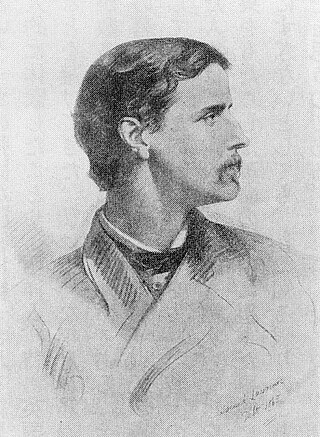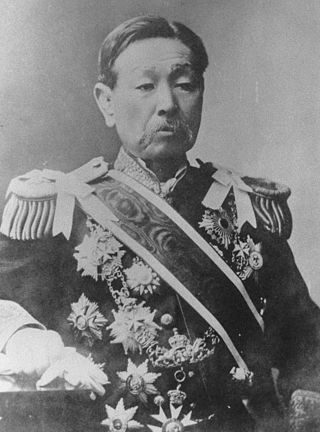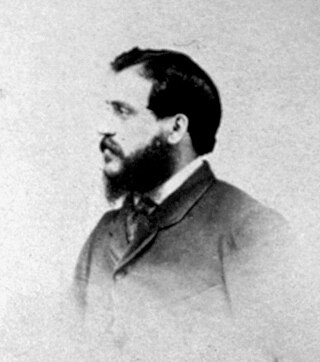
Bakumatsu was the final years of the Edo period when the Tokugawa shogunate ended. Between 1853 and 1867, Japan ended its isolationist foreign policy known as sakoku and changed from a feudal Tokugawa shogunate to the modern empire of the Meiji government. The major ideological-political divide during this period was between the pro-imperial nationalists called ishin shishi and the shogunate forces, which included the elite shinsengumi swordsmen.

Yamate (山手) is the name of a historic neighbourhood in Naka-ku, Yokohama often referred to in English as The Bluff. The neighbourhood is famous as having been a foreigners' residential area in the Bakumatsu, Meiji and Taishō periods. While still dominantly residential in character, with views over downtown Yokohama, historic residential properties, ornamental gardens and public parks, the area is also a popular visitor destination.

Algernon Bertram Freeman-Mitford, 1st Baron Redesdale, was a British diplomat, collector, and writer who wrote as A.B. Mitford. His most notable work is Tales of Old Japan (1871). He was the paternal grandfather of the Mitford sisters.

Japan–United Kingdom relations are the bilateral and diplomatic relations between Japan and the United Kingdom.

Charles Wirgman was an English artist and cartoonist, the creator of the Japan Punch and illustrator in China and Meiji period-Japan for the Illustrated London News.

Marquess Inoue Kaoru was a Japanese politician and a prominent member of the Meiji oligarchy during the Meiji period of the Empire of Japan. As one of the senior statesmen (Genrō) in Japan during that period, he had a tremendous influence on the selection of the nation's leaders and formation of its policies.

Prince Komatsu Akihito was a Japanese career officer in the Imperial Japanese Army, who was a member of the Fushimi-no-miya, one of the shinnōke branches of the Imperial Family of Japan, which were eligible to succeed to the Chrysanthemum Throne.

Ueno Hikoma was a pioneer Japanese photographer, born in Nagasaki. He is noted for his fine portraits, often of important Japanese and foreign figures, and for his excellent landscapes, particularly of Nagasaki and its surroundings. Ueno was a major figure in nineteenth-century Japanese photography as a commercially and artistically successful photographer and as an instructor.

Adolfo Farsari was an Italian photographer based in Yokohama, Japan. His studio, the last notable foreign-owned studio in Japan, was one of the country's largest and most prolific commercial photographic firms. Largely due to Farsari's exacting technical standards and his entrepreneurial abilities, it had a significant influence on the development of photography in Japan.

Felice Beato, also known as Felix Beato, was an Italian–British photographer. He was one of the first people to take photographs in East Asia and one of the first war photographers. He is noted for his genre works, portraits, and views and panoramas of the architecture and landscapes of Asia and the Mediterranean region. Beato's travels gave him the opportunity to create images of countries, people, and events that were unfamiliar and remote to most people in Europe and North America. His work provides images of such events as the Indian Rebellion of 1857 and the Second Opium War, and represents the first substantial body of photojournalism. He influenced other photographers, and his influence in Japan, where he taught and worked with numerous other photographers and artists, was particularly deep and lasting.

Moshun Maru was a three-masted composite-hulled sailing ship of the Bakumatsu and early Meiji periods, with an auxiliary steam engine. She was built in 1867 on the River Thames, serving with the navy of Saga Domain, and later with the fledgling Imperial Japanese Navy.

Chōyō Maru was an early sail and screw-driven steam corvette. She was ordered by the Tokugawa shogunate ruling Japan during the Bakumatsu period from the Netherlands and served as a training vessel, and subsequently served with the nascent Imperial Japanese Navy during the Boshin War. She was lost in combat during the Naval Battle of Hakodate Bay.
Abel Anthony James Gower was a British consul at two posts in Japan during the Bakumatsu period: Nagasaki and Hakodate. He was also an amateur photographer.

Godai Tomoatsu was one of the Satsuma students of 1865 who were smuggled out of Bakumatsu period Japan to study in Great Britain. He returned to become Japan's leading entrepreneur of the early Meiji period.

William Kinnimond Burton was a Scottish engineer, photographer and photography writer, born in Edinburgh, Scotland, who lived most of his career in Meiji era Japan.

Thomas James Waters was an Irish civil engineer and architect. He was active in Bakumatsu and early Meiji period Japan.

Shimooka Renjō was a Japanese photographer and was one of the first professional photographers in Japan. He opened the first commercial photography studio in Yokohama, and in Japan he is widely considered the father of Japanese photography.

Tokugawa Akitake was a younger half-brother of the Japanese Shōgun Tokugawa Yoshinobu and final daimyō of Mito Domain. He represented the Tokugawa shogunate at the courts of several European powers during the final days of Bakumatsu period Japan.
The history of photography in Japan begins in the 19th century and has continued to be a prominent art form into the present era.

HMS Princess Royal was a 91-gun second rate ship of the line of the Royal Navy, launched on 23 June 1853 at Portsmouth.




















